Power Consumption
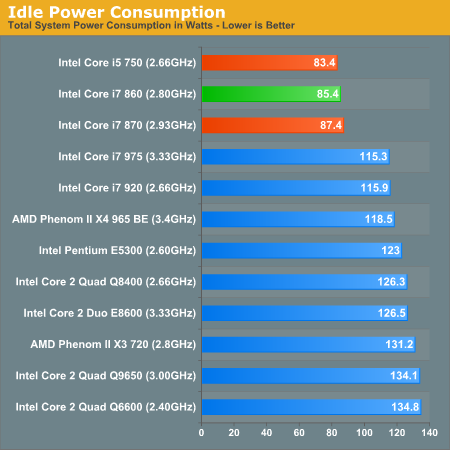
The Core i7 860's power consumption at idle is nice and low, as expected thanks to power gating and low TDP of Lynnfield.
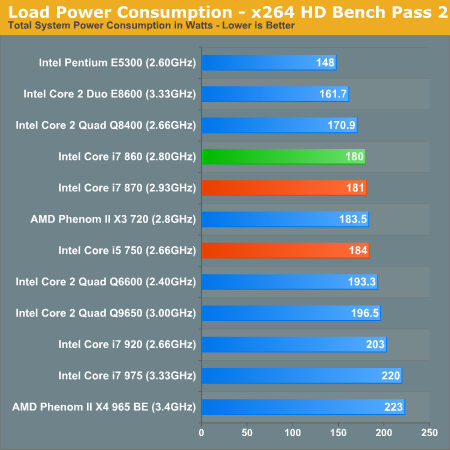
Overclocking
Gary actually handled the overclocking of the 860 before it got into my hands, thankfully this sample seemed to fare better than our first i7 860.
First, our stock voltage overclock with the retail cooler, 3.33GHz:
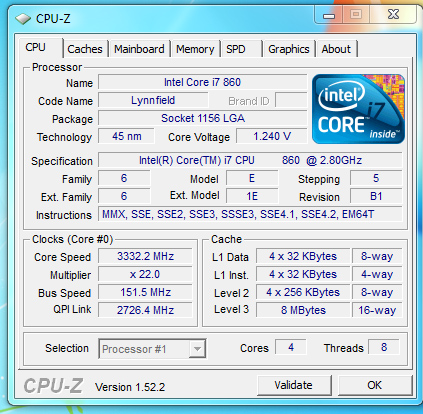
Four cores under load, turbo enabled, stock voltage, retail cooler
Next, max overclock with turbo enabled again using the retail cooler, 3.53GHz (four cores active):
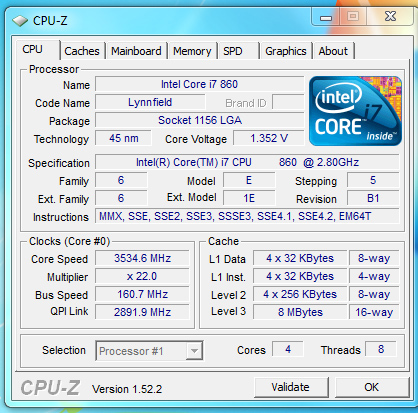
Max overclock, four cores under load, turbo enabled, retail cooler
And finally the max overclock with no turbo. Once more, using the retail cooler:
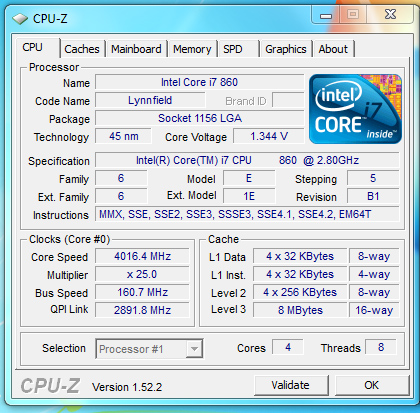
Max overclock, single core load, no turbo
The rule of thumb with Lynnfield appears to be 3 - 3.3GHz overclocks at stock voltage, 3.8GHz+ is possible with additional voltage.










121 Comments
View All Comments
strikeback03 - Monday, September 21, 2009 - link
In previous tests Anand has used the fastest validated speed for each platform, so 1066 for Bloomfield and 1333 for Lynnfield. Not that it probably makes much difference in anything but synthetic benchmarks.Scheme - Saturday, September 19, 2009 - link
Woah, did you forget to take your ritalin last night?mesiah - Saturday, September 19, 2009 - link
Anand, can't you ban this guy? You have to be tired of watching him come on here and verbally assault any person he doesn't agree with, including yourself. Do everyone a favor and toss him to the curb.jonup - Sunday, September 20, 2009 - link
Noooo! This would be too cruel. We need a joker to make us laugh from time to time.tim851 - Saturday, September 19, 2009 - link
Let me guess, you have an i7 920...?Of course the 860 ran at higher clock speeds, why would Anand underclock it? It was compared to the 920 because they share the same price point. That is until you add the motherboard, then the i7 is like 100$ more expensive.
And Anand summed it up nicely: the 1366 platform is now for people who need hexa-cores someday or who think SLI/Crossfire is reasonable.
Oh, and if the P55 Platform is "braindamaged", then apparently all major tech sites are in on the conspiracy.
jordanclock - Saturday, September 19, 2009 - link
What do you mean by "inferior memory?"And of course the 860 was running at a higher clock rate: That's how it is designed to run. Even without Turbo.
TA152H - Saturday, September 19, 2009 - link
I don't have a problem with the 860 running at higher clock speeds, but if the architecture were better, it would never lose to a processor running at lower clock speeds.In short, the architecture is not clearly better. It's worse, the margin is the only thing worth discussing.
TA152H - Saturday, September 19, 2009 - link
I should have said, i7 920 still outperformed it in a few benchmarks.Pity there isn't an edit.
JumpingJack - Saturday, September 19, 2009 - link
The basic architecture of Lynnfield is the same as Bloomfield. The differences are the topology of the platform (PCI on die instead of in the chipset, 2 mem controllers instead of 3, no QPI in Lynnfield). The cores are exactly the same, the cache is exactly the same.jordanclock - Saturday, September 19, 2009 - link
I have yet to see any real world scenarios where triple channel memory "really shines." The inclusion or exclusion of a triple channel set up would account for variations of about 1% either way. In other words, less than the margin of error.